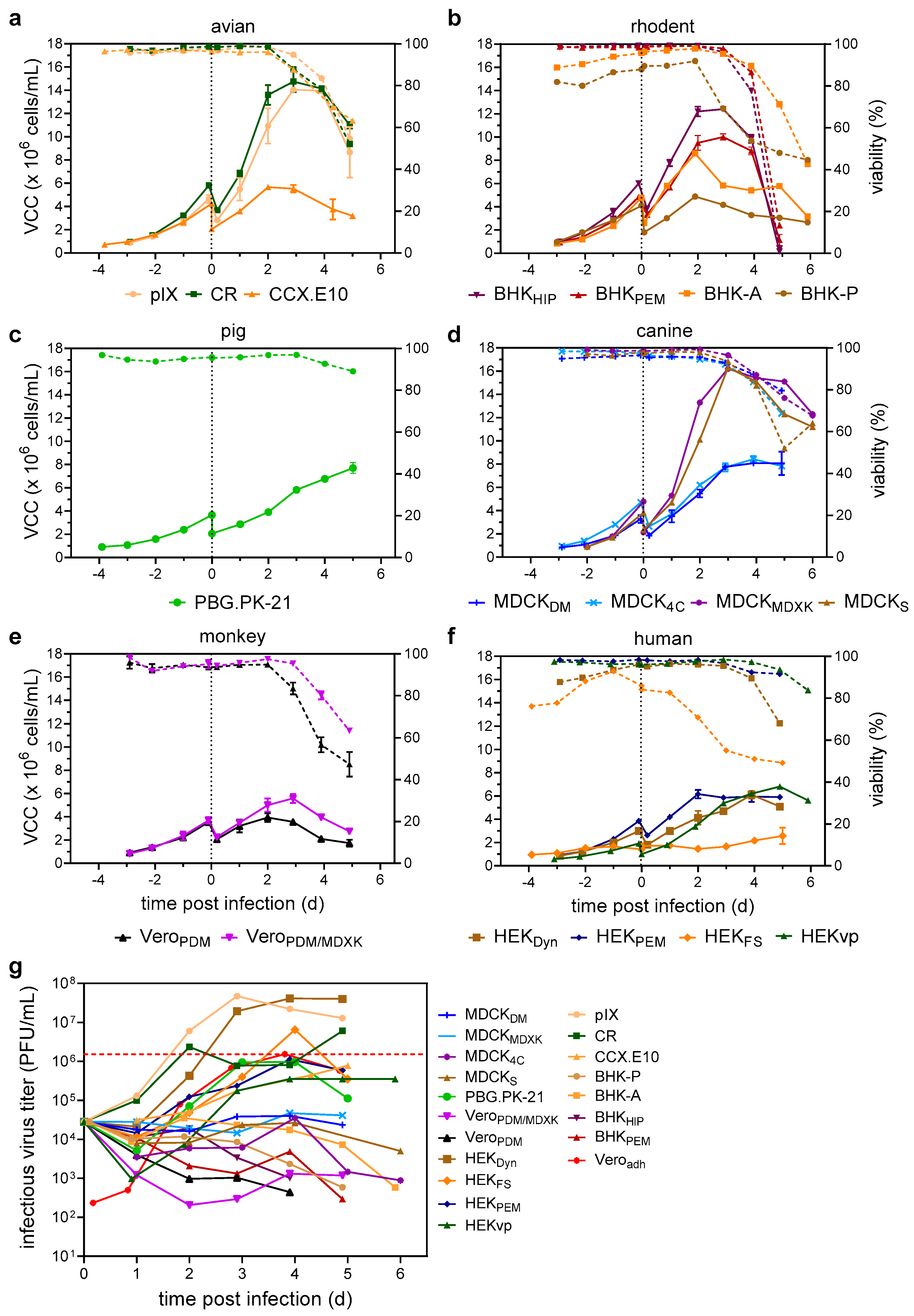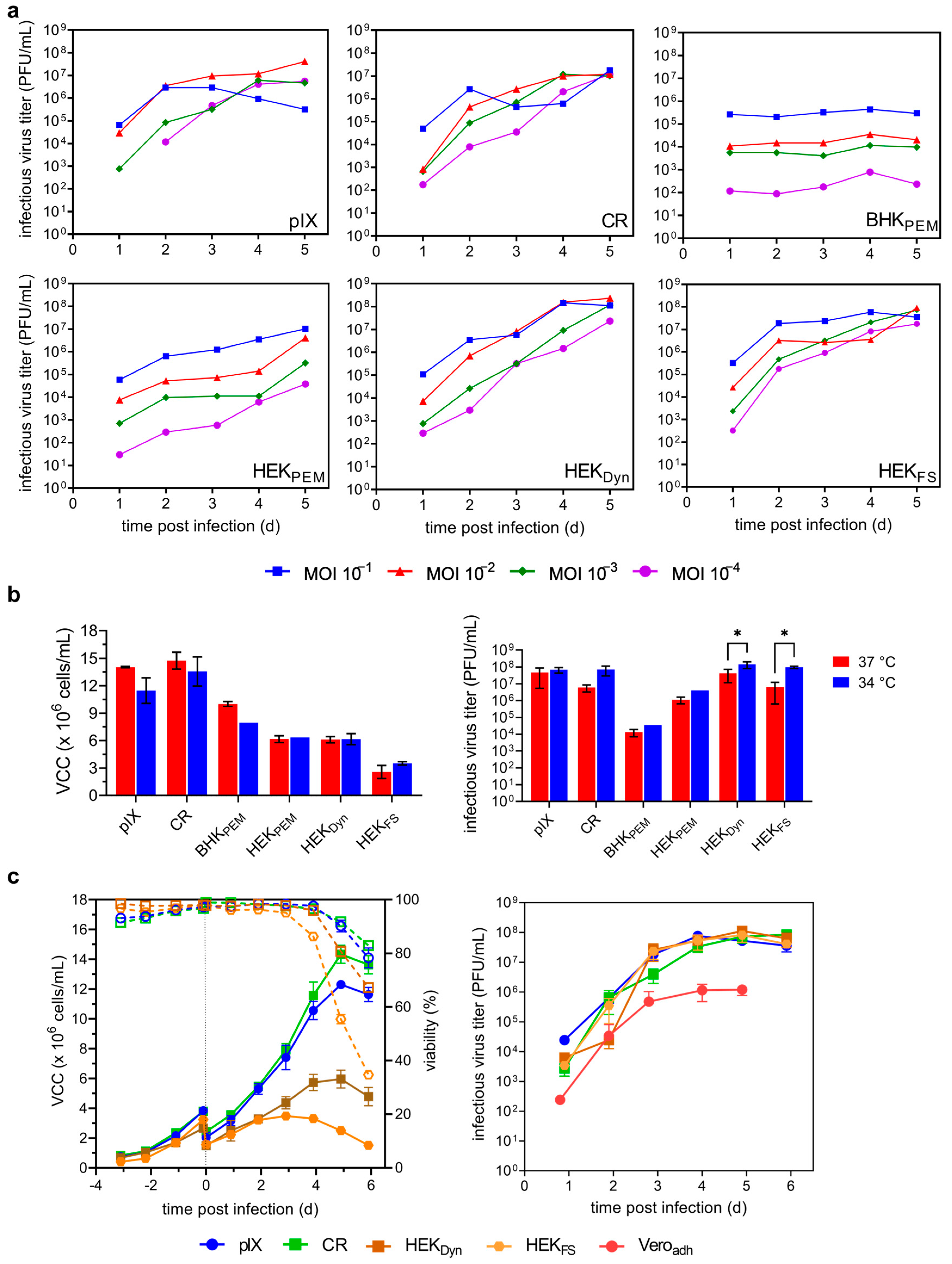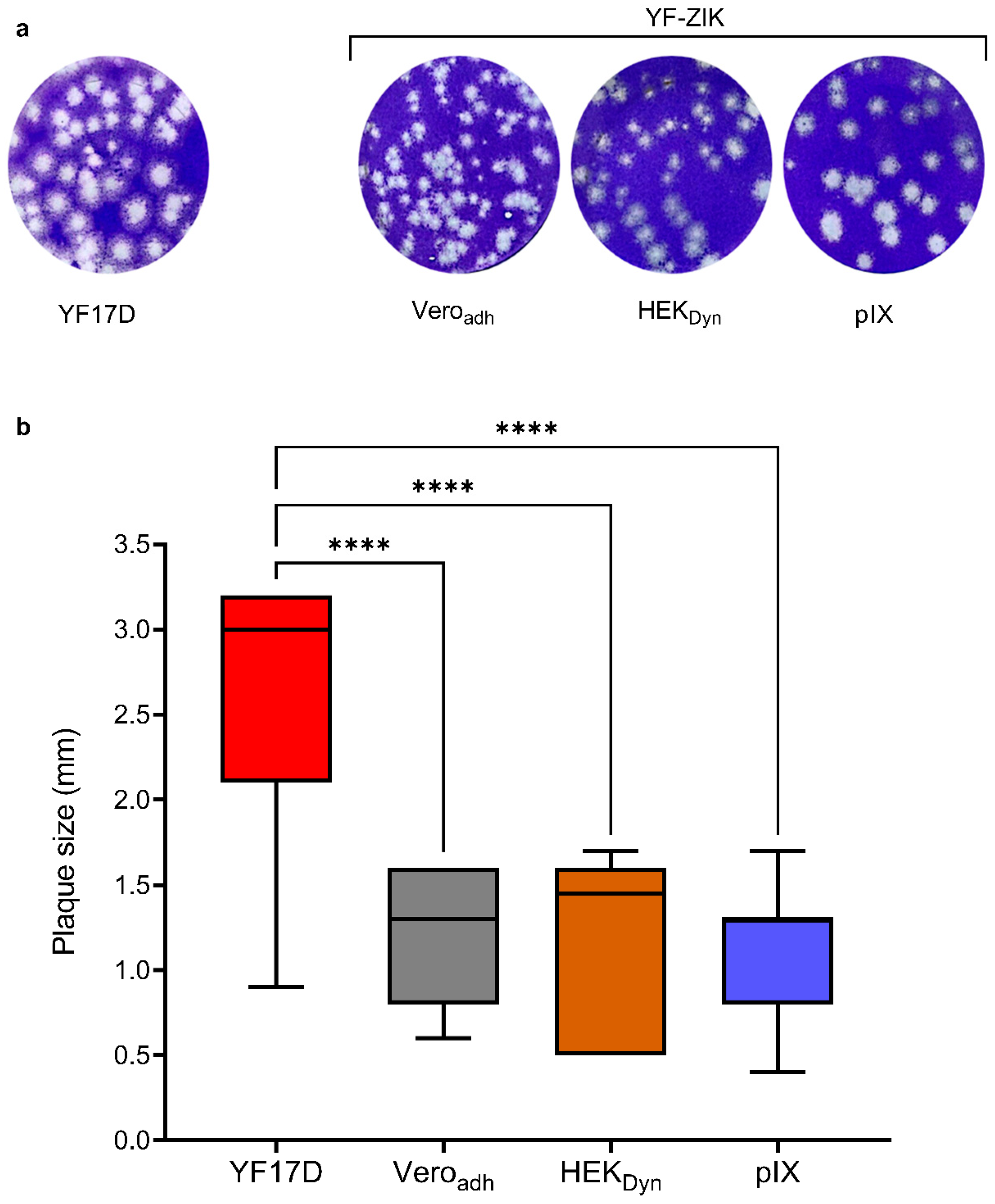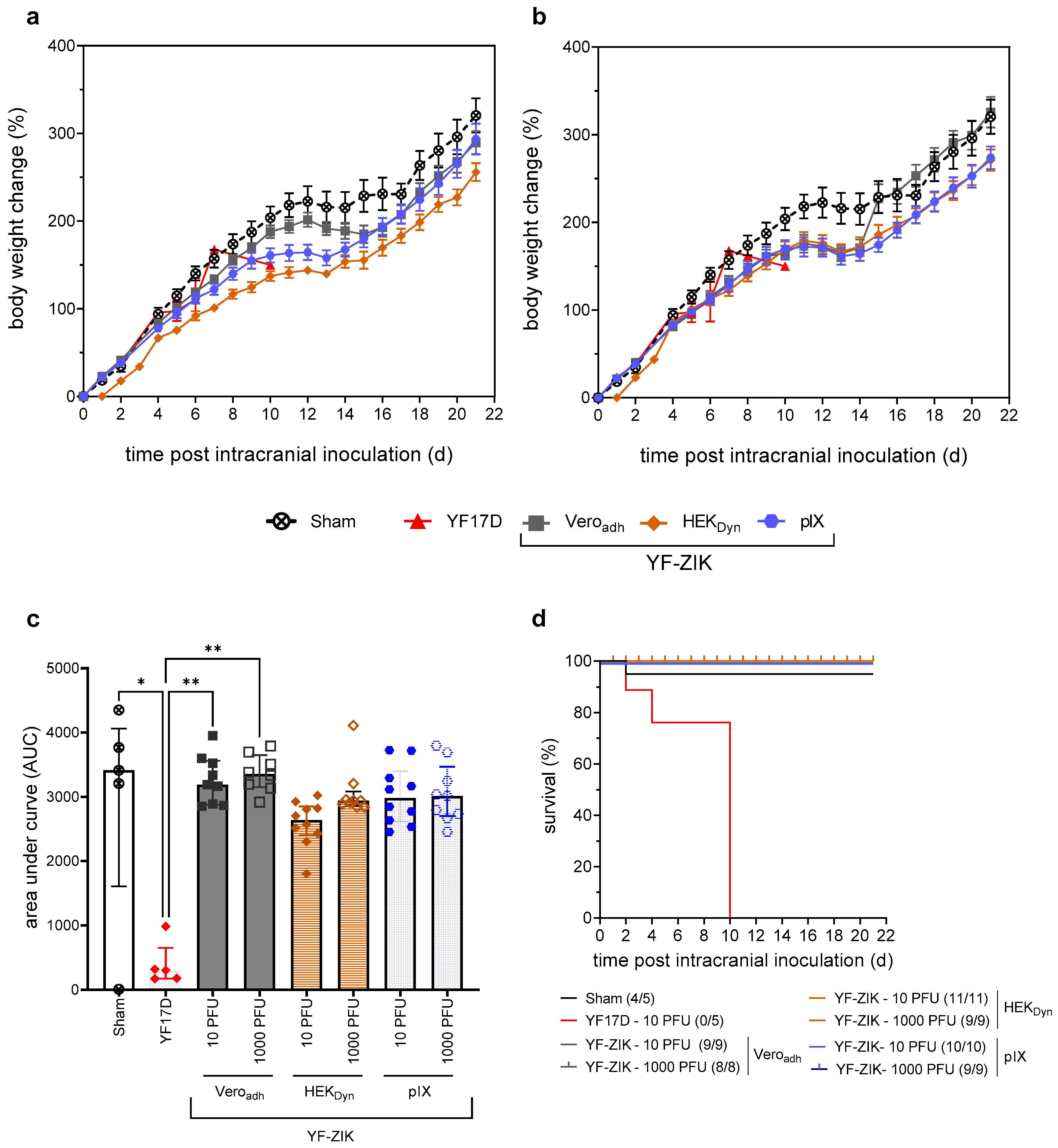Parallel Multifactorial Process Optimization and Intensification for High-Yield Production of Live YF17D-Vectored Zika Vaccine
Abstract
:1. Introduction
2. Materials and Methods
2.1. Cell Lines, Media, and Viral Seed Stock
2.2. YF-ZIK Batch Production
2.3. YF-ZIK Fed-Batch Production
2.4. Plaque Assay
2.5. Reverse-Transcription Chain Reaction (RT-PCR) and Sequencing
2.6. Mice
2.7. Serum Neutralizing Titers
2.8. Calculations
2.9. Statistical Analysis
3. Results
3.1. Identification of High-Producing Host Cell Lines
3.2. Accelerated Parallel Assessment of Critical Process Parameters
3.3. Fed-Batch Process with Early Infection at Low MOI
3.4. Scale-Up to Laboratory Scale Stirred Tank Bioreactor
3.5. In Vitro Characterization of STR YF-ZIK Batches from Different Host Cell Lines
3.6. In Vivo Characterization of STR YF-ZIK Batches from Different Host Cell Lines
4. Discussion
4.1. Selection of a Favorable Cell Line
4.2. Optimizing Culture Conditions
4.3. Proof of Concept for Translatability and Scale-Up
4.4. Consistency of Live Vaccine Produced in an Intensified Process
4.5. In Vivo Safety and Immunogenicity
4.6. Implications of Improved Yields
5. Conclusions
Supplementary Materials
Author Contributions
Funding
Institutional Review Board Statement
Informed Consent Statement
Data Availability Statement
Acknowledgments
Conflicts of Interest
Abbreviations
| µ | cell-specific growth rate |
| AUC | area under the curve |
| CSVY | cell-specific virus yield |
| CMC | carboxyl-methyl-cellulose |
| DO | dissolved oxygen |
| ELI | early low infection mode |
| hpi | hours post infection |
| i.p. | intraperitoneal |
| I/NI | ratio of infectious to non-infectious virions |
| JEV | Japanese encephalitis virus |
| MOI | multiplicity of infection |
| nAb | virus-neutralizing antibodies |
| PEM | protein expression medium |
| PFU | plaque-forming units |
| p.i. | post infection |
| PS | porcine kidney stable cells |
| RT-PCR | reverse-transcription chain reaction |
| SEM | standard error of the mean |
| STD | standard deviation |
| SNT | serum neutralizing titers |
| STR | stirred tank bioreactor |
| VCC | viable cell concentration |
| VCCmax | maximum viable cell concentration |
| wv | working volume |
| YF17D | yellow fever vaccine strain 17D |
| YFV | yellow fever virus |
| YF-ZIK | chimeric YF-ZIKprM/E vaccine virus |
| ZIKV | Zika virus |
References
- Fauci, A.S.; Morens, D.M. Zika Virus in the Americas—Yet Another Arbovirus Threat. N. Engl. J. Med. 2016, 374, 601–604. [Google Scholar] [CrossRef]
- Musso, D.; Ko, A.I.; Baud, D. Zika Virus Infection—After the Pandemic. N. Engl. J. Med. 2019, 381, 1444–1457. [Google Scholar] [CrossRef] [PubMed]
- Yadav, P.D.; Kaur, H.; Gupta, N.; Sahay, R.R.; Sapkal, G.N.; Shete, A.M.; Deshpande, G.R.; Mohandas, S.; Majumdar, T.; Patil, S.; et al. Zika a Vector Borne Disease Detected in Newer States of India Amidst the COVID-19 Pandemic. Front. Microbiol. 2022, 13, 888195. [Google Scholar] [CrossRef]
- Khongwichit, S.; Chuchaona, W.; Vongpunsawad, S.; Poovorawan, Y. Molecular epidemiology, clinical analysis, and genetic characterization of Zika virus infections in Thailand (2020–2023). Sci. Rep. 2023, 13, 21030. [Google Scholar] [CrossRef] [PubMed]
- Plourde, A.R.; Bloch, E.M. A Literature Review of Zika Virus. Emerg. Infect. Dis. 2016, 22, 1185–1192. [Google Scholar] [CrossRef]
- Cao-Lormeau, V.M.; Blake, A.; Mons, S.; Lastère, S.; Roche, C.; Vanhomwegen, J.; Dub, T.; Baudouin, L.; Teissier, A.; Larre, P.; et al. Guillain-Barré Syndrome outbreak associated with Zika virus infection in French Polynesia: A case-control study. Lancet 2016, 387, 1531–1539. [Google Scholar] [CrossRef]
- Lin, H.H.; Yip, B.S.; Huang, L.M.; Wu, S.C. Zika virus structural biology and progress in vaccine development. Biotechnol. Adv. 2018, 36, 47–53. [Google Scholar] [CrossRef]
- Han, H.H.; Diaz, C.; Acosta, C.J.; Liu, M.; Borkowski, A. Safety and immunogenicity of a purified inactivated Zika virus vaccine candidate in healthy adults: An observer-blind, randomised, phase 1 trial. Lancet Infect. Dis. 2021, 21, 1282–1292. [Google Scholar] [CrossRef] [PubMed]
- Medina, L.O.; To, A.; Lieberman, M.M.; Wong, T.A.S.; Namekar, M.; Nakano, E.; Andersen, H.; Yalley-Ogunro, J.; Greenhouse, J.; Higgs, S.; et al. A Recombinant Subunit Based Zika Virus Vaccine Is Efficacious in Non-human Primates. Front. Immunol. 2018, 9, 2464. [Google Scholar] [CrossRef]
- Shan, C.; Muruato, A.E.; Nunes, B.T.D.; Luo, H.; Xie, X.; Medeiros, D.B.A.; Wakamiya, M.; Tesh, R.B.; Barrett, A.D.; Wang, T.; et al. A live-attenuated Zika virus vaccine candidate induces sterilizing immunity in mouse models. Nat. Med. 2017, 23, 763–767. [Google Scholar] [CrossRef]
- Abbink, P.; Stephenson, K.E.; Barouch, D.H. Zika virus vaccines. Nat. Rev. Microbiol. 2018, 16, 594–600. [Google Scholar] [CrossRef] [PubMed]
- Kum, D.B.; Mishra, N.; Boudewijns, R.; Gladwyn-Ng, I.; Alfano, C.; Ma, J.; Schmid, M.A.; Marques, R.E.; Schols, D.; Kaptein, S.; et al. A yellow fever-Zika chimeric virus vaccine candidate protects against Zika infection and congenital malformations in mice. NPJ Vaccines 2018, 3, 56. [Google Scholar] [CrossRef] [PubMed]
- Wang, Y.; Ling, L.; Zhang, Z.; Marin-Lopez, A. Current Advances in Zika Vaccine Development. Vaccines 2022, 10, 1816. [Google Scholar] [CrossRef] [PubMed]
- Bloom, K.; van den Berg, F.; Arbuthnot, P. Self-amplifying RNA vaccines for infectious diseases. Gene Ther. 2021, 28, 117–129. [Google Scholar] [CrossRef] [PubMed]
- Zhang, Y.; Zeng, G.; Pan, H.; Li, C.; Hu, Y.; Chu, K.; Han, W.; Chen, Z.; Tang, R.; Yin, W.; et al. Safety, tolerability, and immunogenicity of an inactivated SARS-CoV-2 vaccine in healthy adults aged 18–59 years: A randomised, double-blind, placebo-controlled, phase 1/2 clinical trial. Lancet Infect. Dis. 2021, 21, 181–192. [Google Scholar] [CrossRef] [PubMed]
- Zhang, G.; Tang, T.; Chen, Y.; Huang, X.; Liang, T. mRNA vaccines in disease prevention and treatment. Signal Transduct. Target. Ther. 2023, 8, 365. [Google Scholar] [CrossRef] [PubMed]
- Theiler, M.; Smith, H.H.; Mortimer, P. The use of yellow fever virus modified by in vitro cultivation for human immunization. Rev. Med. Virol. 2000, 10, 3–16. [Google Scholar] [CrossRef]
- Seligman, S.J. Risk groups for yellow fever vaccine-associated viscerotropic disease (YEL-AVD). Vaccine 2014, 32, 5769–5775. [Google Scholar] [CrossRef] [PubMed]
- Barrett, A.D.; Teuwen, D.E. Yellow fever vaccine—How does it work and why do rare cases of serious adverse events take place? Curr. Opin. Immunol. 2009, 21, 308–313. [Google Scholar] [CrossRef]
- Bonaldo, M.C.; Sequeira, P.C.; Galler, R. The yellow fever 17D virus as a platform for new live attenuated vaccines. Hum. Vaccines Immunother. 2014, 10, 1256–1265. [Google Scholar] [CrossRef]
- Lemmens, V.; Kelchtermans, L.; Debaveye, S.; Chiu, W.; Vercruysse, T.; Ma, J.; Thibaut, H.J.; Neyts, J.; Sanchez-Felipe, L.; Dallmeier, K. YF17D-vectored Ebola vaccine candidate protects mice against lethal surrogate Ebola and yellow fever virus challenge. npj Vaccines 2023, 8, 99. [Google Scholar] [CrossRef]
- Sanchez-Felipe, L.; Vercruysse, T.; Sharma, S.; Ma, J.; Lemmens, V.; Van Looveren, D.; Arkalagud Javarappa, M.P.; Boudewijns, R.; Malengier-Devlies, B.; Liesenborghs, L.; et al. A single-dose live-attenuated YF17D-vectored SARS-CoV-2 vaccine candidate. Nature 2021, 590, 320–325. [Google Scholar] [CrossRef]
- Monath, T.P.; McCarthy, K.; Bedford, P.; Johnson, C.T.; Nichols, R.; Yoksan, S.; Marchesani, R.; Knauber, M.; Wells, K.H.; Arroyo, J.; et al. Clinical proof of principle for ChimeriVax™: Recombinant live, attenuated vaccines against flavivirus infections. Vaccine 2002, 20, 1004–1018. [Google Scholar] [CrossRef]
- Arroyo, J.; Miller, C.; Catalan, J.; Myers, G.A.; Ratterree, M.S.; Trent, D.W.; Monath, T.P. ChimeriVax-West Nile virus live-attenuated vaccine: Preclinical evaluation of safety, immunogenicity, and efficacy. J. Virol. 2004, 78, 12497–12507. [Google Scholar] [CrossRef] [PubMed]
- Giel-Moloney, M.; Goncalvez, A.P.; Catalan, J.; Lecouturier, V.; Girerd-Chambaz, Y.; Diaz, F.; Maldonado-Arocho, F.; Gomila, R.C.; Bernard, M.-C.; Oomen, R.; et al. Chimeric yellow fever 17D-Zika virus (ChimeriVax-Zika) as a live-attenuated Zika virus vaccine. Sci. Rep. 2018, 8, 13206. [Google Scholar] [CrossRef]
- Jones, C.H.; Jenkins, M.P.; Adam Williams, B.; Welch, V.L.; True, J.M. Exploring the future adult vaccine landscape—Crowded schedules and new dynamics. npj Vaccines 2024, 9, 27. [Google Scholar] [CrossRef] [PubMed]
- Kum, D.B.; Boudewijns, R.; Ma, J.; Mishra, N.; Schols, D.; Neyts, J.; Dallmeier, K. A chimeric yellow fever-Zika virus vaccine candidate fully protects against yellow fever virus infection in mice. Emerg. Microbes Infect. 2020, 9, 520–533. [Google Scholar] [CrossRef] [PubMed]
- Nikolay, A.; Castilho, L.R.; Reichl, U.; Genzel, Y. Propagation of Brazilian Zika virus strains in static and suspension cultures using Vero and BHK cells. Vaccine 2018, 36, 3140–3145. [Google Scholar] [CrossRef]
- Yang, Y.; Shan, C.; Zou, J.; Muruato, A.E.; Bruno, D.N.; de Almeida Medeiros Daniele, B.; Vasconcelos, P.F.C.; Rossi, S.L.; Weaver, S.C.; Xie, X.; et al. A cDNA Clone-Launched Platform for High-Yield Production of Inactivated Zika Vaccine. EBioMedicine 2017, 17, 145–156. [Google Scholar] [CrossRef]
- May Fulton, C.; Bailey, W.J. Live Viral Vaccine Neurovirulence Screening: Current and Future Models. Vaccines 2021, 9, 710. [Google Scholar] [CrossRef]
- Kum, D.B.; Mishra, N.; Vrancken, B.; Thibaut, H.J.; Wilder-Smith, A.; Lemey, P.; Neyts, J.; Dallmeier, K. Limited evolution of the yellow fever virus 17d in a mouse infection model. Emerg. Microbes Infect. 2019, 8, 1734–1746. [Google Scholar] [CrossRef]
- Ramin, E.; Cardillo, A.G.; Liebers, R.; Schmölder, J.; von Lieres, E.; Van Molle, W.; Niebel, B.; Natalis, L.; Meln, I.; Perea-Vélez, M.; et al. Accelerating vaccine manufacturing development through model-based approaches: Current advances and future opportunities. Curr. Opin. Chem. Eng. 2024, 43, 100998. [Google Scholar] [CrossRef]
- Sallard, E.; Zhang, W.; Aydin, M.; Schröer, K.; Ehrhardt, A. The Adenovirus Vector Platform: Novel Insights into Rational Vector Design and Lessons Learned from the COVID-19 Vaccine. Viruses 2023, 15, 204. [Google Scholar] [CrossRef]
- Coughlan, L.; Kremer, E.J.; Shayakhmetov, D.M. Adenovirus-based vaccines—A platform for pandemic preparedness against emerging viral pathogens. Mol. Ther. 2022, 30, 1822–1849. [Google Scholar] [CrossRef]
- Joe, C.C.D.; Segireddy, R.R.; Oliveira, C.; Berg, A.; Li, Y.; Doultsinos, D.; Scholze, S.; Ahmad, A.; Nestola, P.; Niemann, J.; et al. Accelerated and intensified manufacturing of an adenovirus-vectored vaccine to enable rapid outbreak response. Biotechnol. Bioeng. 2024, 121, 176–191. [Google Scholar] [CrossRef]
- Mendonça, S.A.; Lorincz, R.; Boucher, P.; Curiel, D.T. Adenoviral vector vaccine platforms in the SARS-CoV-2 pandemic. npj Vaccines 2021, 6, 97. [Google Scholar] [CrossRef] [PubMed]
- Tahara, M.; Takeda, M.; Shirogane, Y.; Hashiguchi, T.; Ohno, S.; Yanagi, Y. Measles virus infects both polarized epithelial and immune cells by using distinctive receptor-binding sites on its hemagglutinin. J. Virol. 2008, 82, 4630–4637. [Google Scholar] [CrossRef] [PubMed]
- Göbel, S.; Kortum, F.; Chavez, K.J.; Jordan, I.; Sandig, V.; Reichl, U.; Altomonte, J.; Genzel, Y. Cell-line screening and process development for a fusogenic oncolytic virus in small-scale suspension cultures. Appl. Microbiol. Biotechnol. 2022, 106, 4945–4961. [Google Scholar] [CrossRef]
- Grein, T.A.; Schwebel, F.; Kress, M.; Loewe, D.; Dieken, H.; Salzig, D.; Weidner, T.; Czermak, P. Screening different host cell lines for the dynamic production of measles virus. Biotechnol. Prog. 2017, 33, 989–997. [Google Scholar] [CrossRef]
- Lindenbach, B.D.; Rice, C.M. trans-Complementation of yellow fever virus NS1 reveals a role in early RNA replication. J. Virol. 1997, 71, 9608–9617. [Google Scholar] [CrossRef]
- Park, Y.W.; Lee, K.S.; Lee, B.-Y.; Park, M.; Kim, H.; Kim, Y.-H.; Lee, S.-J. Mdck-Derived Cell Lines Adapted to Serum-Free Culture and Suspension Culture and Method for Preparing Vaccine Virus Using the Cells. U.S. Patent Application 13/785,757, 13 May 2015. [Google Scholar]
- Nikolay, A. Intensified Yellow Fever and Zika Virus Production in Animal Cell Culture; Otto-von-Guericke-Universität Magdeburg: Magdeburg, Germany, 2020. [Google Scholar]
- Wechuck, J.B.; Ozuer, A.; Goins, W.F.; Wolfe, D.; Oligino, T.; Glorioso, J.C.; Ataai, M.M. Effect of temperature, medium composition, and cell passage on production of herpes-based viral vectors. Biotechnol. Bioeng. 2002, 79, 112–119. [Google Scholar] [CrossRef]
- Kaptein, L.C.; Greijer, A.E.; Valerio, D.; van Beusechem, V.W. Optimized conditions for the production of recombinant amphotropic retroviral vector preparations. Gene Ther. 1997, 4, 172–176. [Google Scholar] [CrossRef] [PubMed]
- Petiot, E.; Jacob, D.; Lanthier, S.; Lohr, V.; Ansorge, S.; Kamen, A.A. Metabolic and kinetic analyses of influenza production in perfusion HEK293 cell culture. BMC Biotechnol. 2011, 11, 84. [Google Scholar] [CrossRef] [PubMed]
- Elahi, S.M.; Shen, C.F.; Gilbert, R. Optimization of production of vesicular stomatitis virus (VSV) in suspension serum-free culture medium at high cell density. J. Biotechnol. 2019, 289, 144–149. [Google Scholar] [CrossRef] [PubMed]
- Gélinas, J.-F.; Azizi, H.; Kiesslich, S.; Lanthier, S.; Perdersen, J.; Chahal, P.S.; Ansorge, S.; Kobinger, G.; Gilbert, R.; Kamen, A.A. Production of rVSV-ZEBOV in serum-free suspension culture of HEK 293SF cells. Vaccine 2019, 37, 6624–6632. [Google Scholar] [CrossRef] [PubMed]
- Audsley, J.M.; Tannock, G.A. The growth of attenuated influenza vaccine donor strains in continuous cell lines. J. Virol. Methods 2005, 123, 187–193. [Google Scholar] [CrossRef]
- Rüdiger, D.; Kupke, S.Y.; Laske, T.; Zmora, P.; Reichl, U. Multiscale modeling of influenza A virus replication in cell cultures predicts infection dynamics for highly different infection conditions. PLoS Comput. Biol. 2019, 15, e1006819. [Google Scholar] [CrossRef]
- Kiesslich, S.; Vila-Chã Losa, J.P.; Gélinas, J.F.; Kamen, A.A. Serum-free production of rVSV-ZEBOV in Vero cells: Microcarrier bioreactor versus scale-X™ hydro fixed-bed. J. Biotechnol. 2020, 310, 32–39. [Google Scholar] [CrossRef]
- Gränicher, G.; Babakhani, M.; Göbel, S.; Jordan, I.; Marichal-Gallardo, P.; Genzel, Y.; Reichl, U. A high cell density perfusion process for Modified Vaccinia virus Ankara production: Process integration with inline DNA digestion and cost analysis. Biotechnol. Bioeng. 2021, 118, 4720–4734. [Google Scholar] [CrossRef]
- Li, Y.P.; Ramirez, S.; Jensen, S.B.; Purcell, R.H.; Gottwein, J.M.; Bukh, J. Highly efficient full-length hepatitis C virus genotype 1 (strain TN) infectious culture system. Proc. Natl. Acad. Sci. USA 2012, 109, 19757–19762. [Google Scholar] [CrossRef]
- Nienow, A.W.; Rielly, C.D.; Brosnan, K.; Bargh, N.; Lee, K.; Coopman, K.; Hewitt, C.J. The physical characterisation of a microscale parallel bioreactor platform with an industrial CHO cell line expressing an IgG4. Biochem. Eng. J. 2013, 76, 25–36. [Google Scholar] [CrossRef]
- Göbel, S.; Jaén, K.E.; Fernandes, R.P.; Reiter, M.; Altomonte, J.; Reichl, U.; Genzel, Y. Characterization of a quail suspension cell line for production of a fusogenic oncolytic virus. Biotechnol. Bioeng. 2023, 120, 3335–3346. [Google Scholar] [CrossRef] [PubMed]
- Chen, P.; Demirji, J.; Ivleva, V.B.; Horwitz, J.; Schwartz, R.; Arnold, F. The transient expression of CHIKV VLP in large stirred tank bioreactors. Cytotechnology 2019, 71, 1079–1093. [Google Scholar] [CrossRef] [PubMed]
- Zinnecker, T.; Badri, N.; Araujo, D.; Thiele, K.; Reichl, U.; Genzel, Y. From single-cell cloning to high-yield influenza virus production—Implementing advanced technologies in vaccine process development. Eng. Life Sci. 2024, 24, 2300245. [Google Scholar] [CrossRef] [PubMed]
- Pugachev, K.V.; Guirakhoo, F.; Ocran, S.W.; Mitchell, F.; Parsons, M.; Penal, C.; Girakhoo, S.; Pougatcheva, S.O.; Arroyo, J.; Trent, D.W.; et al. High fidelity of yellow fever virus RNA polymerase. J. Virol. 2004, 78, 1032–1038. [Google Scholar] [CrossRef] [PubMed]
- Davis, E.H.; Beck, A.S.; Strother, A.E.; Thompson, J.K.; Widen, S.G.; Higgs, S.; Wood, T.G.; Barrett, A.D.T. Attenuation of Live-Attenuated Yellow Fever 17D Vaccine Virus Is Localized to a High-Fidelity Replication Complex. mBio 2019, 10, 1–11. [Google Scholar] [CrossRef] [PubMed]
- Beasley, D.W.; Morin, M.; Lamb, A.R.; Hayman, E.; Watts, D.M.; Lee, C.K.; Trent, D.W.; Monath, T.P. Adaptation of yellow fever virus 17D to Vero cells is associated with mutations in structural and non-structural protein genes. Virus Res. 2013, 176, 280–284. [Google Scholar] [CrossRef] [PubMed]
- Converse, J.L.; Kovatch, R.M.; Pulliam, J.D.; Nagle, S.C., Jr.; Snyder, E.M. Virulence and pathogenesis of yellow fever virus serially passaged in cell culture. Appl. Microbiol. 1971, 21, 1053–1057. [Google Scholar] [CrossRef] [PubMed]
- Barrett, A.D.; Monath, T.P.; Cropp, C.B.; Adkins, J.A.; Ledger, T.N.; Gould, E.A.; Schlesinger, J.J.; Kinney, R.M.; Trent, D.W. Attenuation of wild-type yellow fever virus by passage in HeLa cells. J. Gen. Virol. 1990, 71 Pt 10, 2301–2306. [Google Scholar] [CrossRef]
- Ryman, K.D.; Xie, H.; Ledger, T.N.; Campbell, G.A.; Barrett, A.D. Antigenic variants of yellow fever virus with an altered neurovirulence phenotype in mice. Virology 1997, 230, 376–380. [Google Scholar] [CrossRef]
- Ryman, K.D.; Ledger, T.N.; Campbell, G.A.; Watowich, S.J.; Barrett, A.D. Mutation in a 17D-204 vaccine substrain-specific envelope protein epitope alters the pathogenesis of yellow fever virus in mice. Virology 1998, 244, 59–65. [Google Scholar] [CrossRef] [PubMed]
- Chambers, T.J.; Nickells, M. Neuroadapted yellow fever virus 17D: Genetic and biological characterization of a highly mouse-neurovirulent virus and its infectious molecular clone. J. Virol. 2001, 75, 10912–10922. [Google Scholar] [CrossRef] [PubMed]
- Monath, T.P.; Myers, G.A.; Beck, R.A.; Knauber, M.; Scappaticci, K.; Pullano, T.; Tad Archambault, W.; Catalan, J.; Miller, C.; Zhang, Z.-X.; et al. Safety testing for neurovirulence of novel live, attenuated flavivirus vaccines: Infant mice provide an accurate surrogate for the test in monkeys. Biologicals 2005, 33, 131–144. [Google Scholar] [CrossRef] [PubMed]
- Guirakhoo, F.; Zhang, Z.; Myers, G.; Johnson, B.W.; Pugachev, K.; Nichols, R.; Brown, N.; Levenbook, I.; Draper, K.; Cyrek, S.; et al. A single amino acid substitution in the envelope protein of chimeric yellow fever-dengue 1 vaccine virus reduces neurovirulence for suckling mice and viremia/viscerotropism for monkeys. J. Virol. 2004, 78, 9998–10008. [Google Scholar] [CrossRef] [PubMed]
- Galler, R.; Pugachev, K.V.; Santos, C.L.; Ocran, S.W.; Jabor, A.V.; Rodrigues, S.G.; Marchevsky, R.S.; Freire, M.S.; Almeida, L.F.; Cruz, A.C.; et al. Phenotypic and molecular analyses of yellow fever 17DD vaccine viruses associated with serious adverse events in Brazil. Virology 2001, 290, 309–319. [Google Scholar] [CrossRef] [PubMed]
- Esson, R.; Rodrigues De Sousa, E.; Benair, L.; Devard, N.; Soulet, D.; Gillet, A.; Bassard, I.; Falque, S.; Chareyre, A.; Marmin, M.; et al. Phenotypic and genetic characterization of a next generation live-attenuated yellow fever vaccine candidate. Vaccine 2022, 40, 5641–5650. [Google Scholar] [CrossRef] [PubMed]
- Le Ru, A.; Jacob, D.; Transfiguracion, J.; Ansorge, S.; Henry, O.; Kamen, A.A. Scalable production of influenza virus in HEK-293 cells for efficient vaccine manufacturing. Vaccine 2010, 28, 3661–3671. [Google Scholar] [CrossRef] [PubMed]
- Beck, A.; Tesh, R.B.; Wood, T.G.; Widen, S.G.; Ryman, K.D.; Barrett, A.D. Comparison of the live attenuated yellow fever vaccine 17D-204 strain to its virulent parental strain Asibi by deep sequencing. J. Infect. Dis. 2014, 209, 334–344. [Google Scholar] [CrossRef] [PubMed]
- Dangsagul, W.; Ruchusatsawat, K.; Tawatsin, A.; Changsom, D.; Noisumdaeng, P.; Putchakarn, S.; Phatihattakorn, C.; Auewarakul, P.; Puthavathana, P. Zika virus isolation, propagation, and quantification using multiple methods. PLoS ONE 2021, 16, e0255314. [Google Scholar] [CrossRef]
- Barban, V.; Girerd, Y.; Aguirre, M.; Gulia, S.; Pétiard, F.; Riou, P.; Barrere, B.; Lang, J. High stability of yellow fever 17D-204 vaccine: A 12-year restrospective analysis of large-scale production. Vaccine 2007, 25, 2941–2950. [Google Scholar] [CrossRef]
- Mantel, N.; Girerd, Y.; Geny, C.; Bernard, I.; Pontvianne, J.; Lang, J.; Barban, V. Genetic stability of a dengue vaccine based on chimeric yellow fever/dengue viruses. Vaccine 2011, 29, 6629–6635. [Google Scholar] [CrossRef] [PubMed]
- Meier, K.C.; Gardner, C.L.; Khoretonenko, M.V.; Klimstra, W.B.; Ryman, K.D. A mouse model for studying viscerotropic disease caused by yellow fever virus infection. PLoS Pathog. 2009, 5, e1000614. [Google Scholar] [CrossRef] [PubMed]
- Pato, T.P.; Souza, M.C.O.; Mattos, D.A.; Caride, E.; Ferreira, D.F.; Gaspar, L.P.; Freire, M.S.; Castilho, L.R. Purification of yellow fever virus produced in Vero cells for inactivated vaccine manufacture. Vaccine 2019, 37, 3214–3220. [Google Scholar] [CrossRef] [PubMed]







| Cell Line | VCCmax p.i. (106 Cells/mL) | µ (1/h) | µinf (1/h) | inf. vir. Titer (106 PFU/mL) | CSVY (PFU/Cell) |
|---|---|---|---|---|---|
| VeroPDM | 4.0 ± 0.4 | 0.02 ± 0.003 | 0.015 | <0.01 | <0.1 |
| VeroPDM/MDXK | 5.6 ± 0.4 | 0.022 | 0.014 | <0.01 | <0.1 |
| pIX | 14.1 ± 0.1 | 0.024 | 0.024 | 55.9 ± 29.1 | 4 ± 2 |
| CR | 14.8 ± 0.9 | 0.026 ± 0.002 | 0.021 ± 0.001 | 6.0 ± 2.7 | <1 |
| CCX.E10 | 5.7 ± 0.1 | 0.020 | 0.010 | 0.8 ± 0.1 | <0.1 |
| BHKPEM | 10.0 ± 0.3 | 0.024 ± 0.002 | 0.017 ± 0.001 | <0.01 | <0.1 |
| BHKHIP | 12.4 ± 0.1 | 0.027 | 0.018 | 0.02 | <0.1 |
| BHK-PPEM | 4.8 ± 0.3 | 0.024 ± 0.001 | 0.022 ± 0.001 | <0.01 | <0.1 |
| HEKPEM | 6.2 ± 0.4 | 0.021 ± 0.002 | 0.020 ± 0.001 | 1.1 ± 0.4 | <1 |
| HEKFS | 2.6 ± 0.7 | 0.008 | 0.010 ± 0.002 | 10.6 ± 5.8 | 4 ± 2 |
| HEKDyn | 6.1 ± 0.3 | 0.018 | 0.014 | 55.0 ± 13.7 | 9 ± 2 |
| HEKvs | 6.8 ± 0.4 | 0.017 ± 0.002 | 0.017 ± 0.002 | 0.3 ± 0.1 | <0.1 |
| PBG.PK-21 | 7.7 ± 0.5 | 0.014 ± 0.001 | 0.011 | 0.1 | <0.1 |
| MDCKMDXK | 16.2 ± 0.3 | 0.035 ± 0.001 | 0.028 | <0.01 | <0.1 |
| MDCKDM | 8.1 ± 0.1 | 0.02 ± 0.002 | 0.017 | <0.01 | <0.1 |
| MDCK4C | 8.4 ± 0.3 | 0.023 ± 0.001 | 0.013 | <0.01 | <0.1 |
| MDCKS | 16.3 ± 0.2 | 0.031 ± 0.002 | 0.027 | <0.01 | <0.1 |
| Veroadh | 2.5 ± 0.1 | 0.028 ± 0.001 | 0.003 ± 0.001 | 1.5 ± 0.1 | <1 |
| Cell Line | MOI | VCCmax p.i. (106 Cells/mL) | µ (1/h) | µinf (1/h) | inf. vir. Titer (107 PFU/mL) | CSVY (PFU/Cell) |
|---|---|---|---|---|---|---|
| pIX | 0.01 | 12.3 ± 0.2 | 0.022 ± 0.006 | 0.016 ± 0.006 | 7.7 ± 2.3 | 6 ± 2 |
| CR | 0.001 | 14.3 ± 0.6 | 0.021 ± 0.006 | 0.015 ± 0.004 | 8.5 ± 1.1 | 6 ± 1 |
| HEKDyn | 0.01 | 6.0 ± 0.6 | 0.019 ± 0.004 | 0.013 ± 0.008 | 11.3 ± 1.2 | 19 ± 2 |
| HEKFS | 0.001 | 3.5 ± 0.2 | 0.028 ± 0.007 | 0.012 ± 0.007 | 8.3 ± 3.6 | 24 ± 11 |
Disclaimer/Publisher’s Note: The statements, opinions and data contained in all publications are solely those of the individual author(s) and contributor(s) and not of MDPI and/or the editor(s). MDPI and/or the editor(s) disclaim responsibility for any injury to people or property resulting from any ideas, methods, instructions or products referred to in the content. |
© 2024 by the authors. Licensee MDPI, Basel, Switzerland. This article is an open access article distributed under the terms and conditions of the Creative Commons Attribution (CC BY) license (https://creativecommons.org/licenses/by/4.0/).
Share and Cite
Göbel, S.; Kazemi, O.; Ma, J.; Jordan, I.; Sandig, V.; Paulissen, J.; Kerstens, W.; Thibaut, H.J.; Reichl, U.; Dallmeier, K.; et al. Parallel Multifactorial Process Optimization and Intensification for High-Yield Production of Live YF17D-Vectored Zika Vaccine. Vaccines 2024, 12, 755. https://doi.org/10.3390/vaccines12070755
Göbel S, Kazemi O, Ma J, Jordan I, Sandig V, Paulissen J, Kerstens W, Thibaut HJ, Reichl U, Dallmeier K, et al. Parallel Multifactorial Process Optimization and Intensification for High-Yield Production of Live YF17D-Vectored Zika Vaccine. Vaccines. 2024; 12(7):755. https://doi.org/10.3390/vaccines12070755
Chicago/Turabian StyleGöbel, Sven, Ozeir Kazemi, Ji Ma, Ingo Jordan, Volker Sandig, Jasmine Paulissen, Winnie Kerstens, Hendrik Jan Thibaut, Udo Reichl, Kai Dallmeier, and et al. 2024. "Parallel Multifactorial Process Optimization and Intensification for High-Yield Production of Live YF17D-Vectored Zika Vaccine" Vaccines 12, no. 7: 755. https://doi.org/10.3390/vaccines12070755







